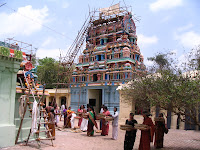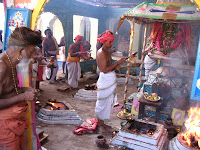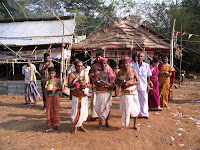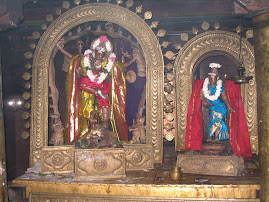I considered myself as fortunate when I came across a beautiful narration on the Sivagamas in a web site.The author seemed to be a voracious reader of this subject.He has pointed out how the South had preserved the tradition during difficult times caused by the invasion of foreigners.I would like to share with the readers the portion of his text that supports the view.
"The agamas had existed mostly in South India, in Tamilnadu, in palm leaf manuscriptbook form in the homes of the Sivachariyas who had been entrusted with the duty of organizing and performing the consecration and the congregational worship (pararthapuja) in the Siva temples for probably over two millennia and a half. These Agamas are not available in north India to the extent they are available in the south, although they had been responsible for the culture of the whole of India. Dr. Das Gupta has stated that "No Agama manuscript of any importance is found even in Banaras, the greatest center ofHindu religion, Sanskrit studies and culture.""The general assumption that the Agamas deal only with temples and temple worship is wrong.The Agamas consist of four parts of which Kriya dealing with temple construction and rituals is one, and jnana dealing with philosophy is another. Theyare as much philosophic treatises as any other treatises like the Upanishads. The Agamas are encyclopaedic in their treatment of all subjects pertaining to the religious life of the worshipper and to the temple."The details of temple construction here given are beyond what an excellent modern architect can dream of.Other allied subjects dealt with here are sculpture, iconography, construction of the templecar, geology, horticulture, astronomy, town planning, home science, water supply, healthand hygiene, food and many others. In short, we may say no area of human activity of theperiod about 2,000 years back has been left out."
With this introduction to the Sivagama,I now take you over to the consecration of some siva temples held in March.The first one was at Thirukkottaru,a place south ea st of Mayiladuthurai.The Lord is worshipped here by the elephant of Devendra,called Iravadha.Hence the deity is named as Iravadheeswara.
st of Mayiladuthurai.The Lord is worshipped here by the elephant of Devendra,called Iravadha.Hence the deity is named as Iravadheeswara.
Thirugnanasambandar has visited this place in the 7th century and sung 11 Thevaram verses in praise of the deity.According to the agama,the consecration has to take place once in 12 years.This gives scope for renovation after necessary repairs of the temple,if required.At the same time it enhances the sanctity of the temple.Due to paucity of funds,the temples find it difficult to practice the ritual as suggested by Agama.The situation is still bad in villages where one can see temples that have not been consecrated for more than 50 years.It is at those places the structure itself has been damaged due to growth of trees over them.Hence the villagers depend mostly on the outsiders to repair and consecrate the temples.Although the Government
temples find it difficult to practice the ritual as suggested by Agama.The situation is still bad in villages where one can see temples that have not been consecrated for more than 50 years.It is at those places the structure itself has been damaged due to growth of trees over them.Hence the villagers depend mostly on the outsiders to repair and consecrate the temples.Although the Government  enjoys the control of majority of the temples of Tamilnadu,it comes forward to renovate only the well known temples unless there is an initiative from the small shrines.However,many temples in the villages are renovated now by the interest shown by the locals and the magnanimity of the philanthropists from outside.Time has come for those who have left their ancestral place and migrated to urban areas to look after the temples of their origin.One has to admit that the earning has increased several folds but the concentration to preserve our culture is lacking.May I appeal to them to spend atleast 1% of their annual income for the upliftment of temples.Let them also remember that they pay Tax to the tune of 20-30% every year to the Govt.but reluctant to contribute for the noble cause.
enjoys the control of majority of the temples of Tamilnadu,it comes forward to renovate only the well known temples unless there is an initiative from the small shrines.However,many temples in the villages are renovated now by the interest shown by the locals and the magnanimity of the philanthropists from outside.Time has come for those who have left their ancestral place and migrated to urban areas to look after the temples of their origin.One has to admit that the earning has increased several folds but the concentration to preserve our culture is lacking.May I appeal to them to spend atleast 1% of their annual income for the upliftment of temples.Let them also remember that they pay Tax to the tune of 20-30% every year to the Govt.but reluctant to contribute for the noble cause.
The other consecration I witnessed recently was at Killikudi,a tiny village,where the whole village had stood up to reconstruct the ancient Siva temple.I share this because I was touched deeply by the act of the villagers who really can not afford to take up such a dream project. It should be an eyeopener for those who have not even thought about the greatness of the culture.

"The agamas had existed mostly in South India, in Tamilnadu, in palm leaf manuscriptbook form in the homes of the Sivachariyas who had been entrusted with the duty of organizing and performing the consecration and the congregational worship (pararthapuja) in the Siva temples for probably over two millennia and a half. These Agamas are not available in north India to the extent they are available in the south, although they had been responsible for the culture of the whole of India. Dr. Das Gupta has stated that "No Agama manuscript of any importance is found even in Banaras, the greatest center ofHindu religion, Sanskrit studies and culture.""The general assumption that the Agamas deal only with temples and temple worship is wrong.The Agamas consist of four parts of which Kriya dealing with temple construction and rituals is one, and jnana dealing with philosophy is another. Theyare as much philosophic treatises as any other treatises like the Upanishads. The Agamas are encyclopaedic in their treatment of all subjects pertaining to the religious life of the worshipper and to the temple."The details of temple construction here given are beyond what an excellent modern architect can dream of.Other allied subjects dealt with here are sculpture, iconography, construction of the templecar, geology, horticulture, astronomy, town planning, home science, water supply, healthand hygiene, food and many others. In short, we may say no area of human activity of theperiod about 2,000 years back has been left out."
With this introduction to the Sivagama,I now take you over to the consecration of some siva temples held in March.The first one was at Thirukkottaru,a place south ea
 st of Mayiladuthurai.The Lord is worshipped here by the elephant of Devendra,called Iravadha.Hence the deity is named as Iravadheeswara.
st of Mayiladuthurai.The Lord is worshipped here by the elephant of Devendra,called Iravadha.Hence the deity is named as Iravadheeswara.Thirugnanasambandar has visited this place in the 7th century and sung 11 Thevaram verses in praise of the deity.According to the agama,the consecration has to take place once in 12 years.This gives scope for renovation after necessary repairs of the temple,if required.At the same time it enhances the sanctity of the temple.Due to paucity of funds,the
 temples find it difficult to practice the ritual as suggested by Agama.The situation is still bad in villages where one can see temples that have not been consecrated for more than 50 years.It is at those places the structure itself has been damaged due to growth of trees over them.Hence the villagers depend mostly on the outsiders to repair and consecrate the temples.Although the Government
temples find it difficult to practice the ritual as suggested by Agama.The situation is still bad in villages where one can see temples that have not been consecrated for more than 50 years.It is at those places the structure itself has been damaged due to growth of trees over them.Hence the villagers depend mostly on the outsiders to repair and consecrate the temples.Although the Government  enjoys the control of majority of the temples of Tamilnadu,it comes forward to renovate only the well known temples unless there is an initiative from the small shrines.However,many temples in the villages are renovated now by the interest shown by the locals and the magnanimity of the philanthropists from outside.Time has come for those who have left their ancestral place and migrated to urban areas to look after the temples of their origin.One has to admit that the earning has increased several folds but the concentration to preserve our culture is lacking.May I appeal to them to spend atleast 1% of their annual income for the upliftment of temples.Let them also remember that they pay Tax to the tune of 20-30% every year to the Govt.but reluctant to contribute for the noble cause.
enjoys the control of majority of the temples of Tamilnadu,it comes forward to renovate only the well known temples unless there is an initiative from the small shrines.However,many temples in the villages are renovated now by the interest shown by the locals and the magnanimity of the philanthropists from outside.Time has come for those who have left their ancestral place and migrated to urban areas to look after the temples of their origin.One has to admit that the earning has increased several folds but the concentration to preserve our culture is lacking.May I appeal to them to spend atleast 1% of their annual income for the upliftment of temples.Let them also remember that they pay Tax to the tune of 20-30% every year to the Govt.but reluctant to contribute for the noble cause.The other consecration I witnessed recently was at Killikudi,a tiny village,where the whole village had stood up to reconstruct the ancient Siva temple.I share this because I was touched deeply by the act of the villagers who really can not afford to take up such a dream project. It should be an eyeopener for those who have not even thought about the greatness of the culture.





It's nice start Sri Sivavathasekaran. I wish that this serves as a good meeting point of all temple lovers/sevaks. By the way, which temple is presented in the header? Nice image.
ReplyDeleteRegards,
Raju
We are indeed happy that we were also able to contribute to this noble cause. While I cotributed a paltry 6000/-, my wife who is from Delhi and who did not have any idea about Tamilnadu temples when she first came to Chennai contributed 10,000/-. We should be grateful to Mr. Vedamurthy of Killukudi for leading the renovation work.
ReplyDelete